Grand Prix > 2007 Grand Prix > Grand Prix of Brazil > Review
|
|
24 Oct, 2007 (Wed)
Thank you for your support over the season. The F1 season started with the Australian GP in Melbourne last March, and now here we are, already at the last race of the year. The setting for the last race of the year is the Interlagos Circuit, the highest elevation circuit of all 17 races. Interlagos is famous as both a counter-clockwise circuit, and a circuit that is physically punishing on the drivers. Without further ado, here is my report from the Brazilian GP, the 17th and final race of this year’s F1 World Championship.
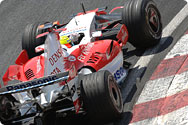 The team combined the new rear wing end plate introduced at the Japanese GP with a different downforce specification for the race in Brazil.
The team combined the new rear wing end plate introduced at the Japanese GP with a different downforce specification for the race in Brazil. Still evolving; bringing new parts to the final race
Despite the fact that this is the last race of the season, we decided to bring new aero parts to Sao Paulo, if even just to score a slightly higher result than otherwise. For one, we brought the new end plate for the rear wing originally developed for our Fuji Special package, and incorporated this into both our medium- to medium-high downforce spec wing. We also introduced a new front wing. We didn’t have this wing ready in time for the Japanese GP, and had to put off introducing the wing at the Chinese GP due to shipping logistics issues.
A Friday of Contrasts—Ralf progresses smoothly, while Jarno struggles with setup
Being notorious for its bumpiness, Interlagos was completely repaved this year, resulting in a much smoother surface. On the first day, both drivers were generally positive, noting that while some bumps remained on the track, none were at any braking points or other important locations.
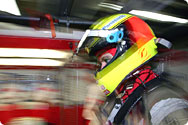 This was Ralf's last GP under the Panasonic Toyota Racing banner. He persevered through tough circumstances to record a complete race.
This was Ralf's last GP under the Panasonic Toyota Racing banner. He persevered through tough circumstances to record a complete race. The first practice session started under wet conditions. But we had word that the weather would clear up for the afternoon session, so we decided to wait in the garage for about 30 minutes at the beginning of the second free practice session to let the track dry. In so doing, we only had 60 minutes out of a 90-minute session to work, but things progressed smoothly, with some adjustments to Ralf’s (Schumacher) rear wing downforce levels being the only changes required.
On the other had, Jarno (Trulli) was going through some trials in finding the right setup. The car was acting “snappy” (sudden loss of rear grip going into corners) under the morning’s wet conditions, leaving Jarno less than satisfied with the car’s handling. After the track surface dried out during the afternoon, the car started developing oversteer issues. We adjusted the rear suspension, lowered the car slightly given the smooth characteristics of the track, reduced the tire pressure somewhat compared to the morning session, and labored over the test data to prepare ourselves for Saturday.
Jarno returns to form in the T-Car; Ralf’s qualifying was the exact opposite of Friday’s performance
We pored over the data to try and pinpoint the cause of Jarno’s problems during Friday’s practice, but we couldn’t find an answer. Accordingly, on Saturday morning we went ahead and switched Jarno to the T-Car. It turned out to be the right decision, and Jarno performed like a completely different driver with the new car. The hotter temperatures on Saturday made it easier to heat up the tires, which was another good break for Jarno.
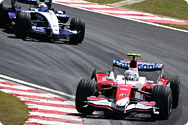 Jarno returned to form after switching to the T-Car. The front wing featured a new specification originally planned for introduction in the prior two races.
Jarno returned to form after switching to the T-Car. The front wing featured a new specification originally planned for introduction in the prior two races. But with the rise in ambient temperatures, the track surface temperature shot up to nearly 50°C, resulting in graining (abrasive wear) in the front and blistering (heat-produced bubbles on the tire surface) in the back for the super-soft tire compound, the softer of the two tire compounds required for the weekend. We were able to change the roll balance to deal with the graining issue, but we were still worried about the blistering, especially considering that we received news indicating Sunday was going to be even hotter than Saturday. A key for the race would be when and how far to run on which tires.
On the other hand, with increasing temperatures, Ralf ran into problems with rear tire movement (sense that the rubber on the tire surface was moving during cornering), causing setup troubles. Ralf qualified P15 on the grid, and Sunday’s race marked the last time that Ralf would be driving for our team. We paid painstaking attention to every detail to make sure there wouldn’t be any problems with the car during Sunday’s race, and we were confident that Ralf would fight tenaciously to the end for us.
Jarno finished the season with 8 championship points, but issues remain
I am happy that we were at least able to capture one championship point at the last race of the season. There is a world of difference between 0 points and 1 point, and I am grateful that Jarno performed steadily and professionally to secure that point. However, Sunday’s race also revealed an issue for us.
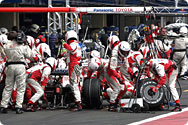 Jarno was scheduled for a 3-stop strategy, while Ralf was on a 2-stop race. Looking at the results, perhaps a 2-stop strategy would have been better, considering that the team wasn’t able to take advantage of the extra speed normally afforded by a 3-stop strategy.
Jarno was scheduled for a 3-stop strategy, while Ralf was on a 2-stop race. Looking at the results, perhaps a 2-stop strategy would have been better, considering that the team wasn’t able to take advantage of the extra speed normally afforded by a 3-stop strategy.
The issue is, despite our 3-stop race strategy, we weren’t able to take advantage. This was due to the fact that blisters started forming on Jarno’s rear tires during the second stint, keeping our pace slower than we expected. Another factor hampering our pace was that we had some graining on our front tires, forcing Jarno to hold down his speed to keep the problem from getting worse.
Tire rubber started accumulating on the track during the middle part of the race, and ultimately we were able to record unexpectedly quick lap times on the super-soft tires, meaning we could have gotten by with just two stops. Perhaps we were a bit too cautious.
In his last race at Toyota, Ralf was tapped by another in the first corner, but he turned in a praiseworthy performance, completing a tough race. We all expect great things of Ralf as he takes on new challenges.
The season is now over, but I want to thank each of you for your support over the last year. Next year, we will have the strong, fast car that I know all of you are expecting from Panasonic Toyota Racing. At that time, I hope you will all be cheering for us again!
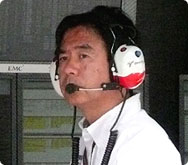
Noritoshi Arai at Interlagos. Panasonic Toyota Racing captured a championship point in the last race of the year! The team will be concentrating all of its efforts on new car development during winter testing, looking for dramatic gains going into next season.